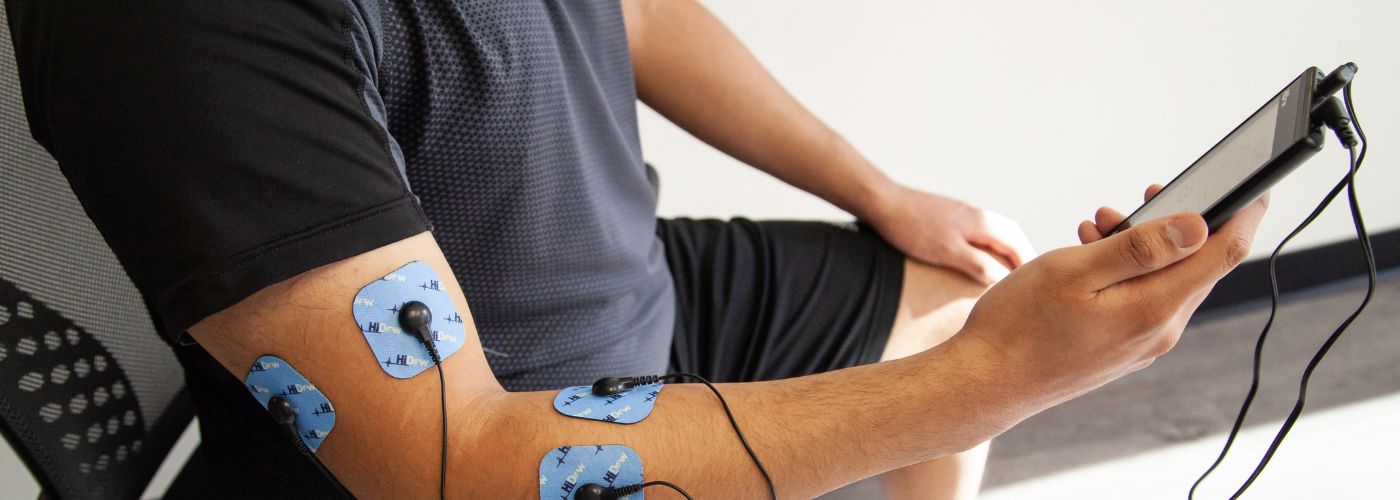Did you know that nearly 1 million people in the U.S. are living with multiple sclerosis (MS)? If you’re one of them, or know someone who is, you might be searching for effective pain relief solutions. In this article, we’ll dive into the world of TENS/EMS devices for multiple sclerosis and explore their potential benefits for those battling MS.
How TENS/EMS Devices Work For Multiple Sclerosis
TENS/EMS devices for multiple sclerosis offer a unique approach to pain management. TENS (Transcutaneous Electrical Nerve Stimulation) utilizes low-voltage electrical currents to stimulate nerves. This noninvasive therapy works by sending electrical impulses through the skin, which may disrupt pain signals traveling to the brain.
EMS (Electrical Muscle Stimulation) works by contracting muscles through electrical stimulation, helping to improve muscle strength and function. This can be particularly beneficial for individuals with multiple sclerosis, as they often experience muscle weakness and spasms.
Interestingly, some MS patients report not only relief from neuropathic pain but also an improvement in overall mood and quality of life. The dual action of blocking pain signals while potentially releasing endorphins creates a holistic experience that may address both physical and emotional challenges associated with the condition.
Some patients find that using TENS during flare-ups or periods of heightened discomfort may provide relief, making it a valuable addition to their toolkit for managing MS.
As ongoing research continues to explore the efficacy of TENS/EMS therapy, more people are discovering its potential as a complementary option alongside conventional treatments.
How To Use TENS Devices For Multiple Sclerosis
Using a TENS device like the Pro Touch 6-12 can be a game-changer for individuals managing the discomfort associated with multiple sclerosis.
With its 12 therapeutic modes, this device allows users to tailor their experience based on specific symptoms, whether it’s muscle spasms, neuropathic pain, or general fatigue.
The ability to adjust between 20 intensity levels means that you can find the perfect setting that provides relief without overwhelming your senses.
One of the standout features of the Pro Touch 6-12 is its capacity to sync up to six wireless devices simultaneously, making it ideal for those who may want to share their experience with a caregiver or family member.
Another great TENS/EMS device for multiple sclerosis is the XP Micro. It features 20 intensity levels, 8 Therapeutic Modes, and 4 electrode pad output channels that allow for customized treatment options tailored to individual needs.
The XP Micro is designed with user-friendliness in mind, featuring a clear LCD display and intuitive controls that make it accessible for users of all ages.
With its lightweight and portable design, the XP Micro can easily be taken on the go, ensuring that relief is always within reach. The device also includes an interactive design, allowing users to set treatment durations according to their preferences, which can be particularly beneficial for managing chronic pain associated with multiple sclerosis.
This functionality not only enhances the treatment experience but also fosters a supportive environment where loved ones can participate in the healing journey. By incorporating this innovative technology into your daily routine, you can explore new avenues of comfort and reclaim some control over your symptoms in a way that feels empowering.
Ways To Personalize Your TENS/EMS Therapy For MS
Personalizing your TENS/EMS therapy can make a significant difference in managing MS-related symptoms such as muscle tightness, fatigue, and discomfort. By adjusting electrode pad placement to match your unique pain and tension points, you can improve the effectiveness of your therapy and enhance relief.
Rather than relying solely on generic placement guides, consider mapping out the areas where you experience the most discomfort. Adjusting pad positions can help target spasticity, muscle weakness, and nerve pain more effectively—allowing you to experience better results tailored to your needs.
For a detailed guide on optimal pad placement, refer to our Pad Placement Brochure to ensure you’re maximizing the benefits of your therapy.
Finding the Right TENS/EMS Mode for MS
HiDow’s TENS/EMS devices offer a variety of stimulation modes designed to address different muscular needs. Here are a few modes that may be particularly helpful for MS-related symptoms, along with the devices that feature them:
HiDow TENS/EMS Device Lineup: Spot | Wireless 4-9 | Pro Touch 6-12 | XP Micro | XPD 12 | XPDS 18 | XPDS 4 | 24
1. Tapping Mode (TENS) – Improve Circulation & Reduce Inflammation
Tapping mode simulates a second heartbeat, delivering rhythmic pulses that increase blood flow, oxygenate muscles, and flush out inflammation. This can be beneficial for MS-related muscle stiffness and swelling by improving circulation in affected areas.
👉 Find this mode on: All HiDow TENS/EMS Devices
2. Hot Stone Mode (TENS) – Relaxation & Nerve Pain Relief
This mode provides a gentle, rolling massage sensation that relaxes soft tissue and soothes muscle tension. For MS patients experiencing neuropathic pain or chronic tightness, this setting may help promote relaxation and comfort.
👉 Find this mode on: Pro Touch 6-12, XP Micro, XPD 12, XPDS 18, XPDS 4|24
3. Kneading Mode (EMS) – Ease Muscle Tension & Improve Flexibility
EMS kneading mode mimics a deep tissue massage, working to release muscle tightness and improve mobility. Since MS can lead to spasticity and muscle stiffness, this mode helps maintain range of motion and reduce cramping.
👉 Find this mode on: SPOT, Wireless 4-9, Pro Touch 6-12, XP Micro, XPD 12, XPDS 18, XPDS 4|24
4. Shuffle Mode (TENS) – Versatile Muscle Relief
Shuffle mode combines multiple stimulation patterns to provide well-rounded muscle relief. This mode is a great choice for cooling down muscles after activity, helping prevent MS-related fatigue and post-exercise soreness.
👉 Find this mode on: SPOT, Pro Touch 6-12, XPD 12, XPDS 18, XPDS 4|24
5. Reflexology Mode (TENS) – Foot & Leg Relief
If MS affects your legs or feet, Reflexology mode may help stimulate nerve endings, improve circulation, and promote relaxation through gentle electrical impulses. This setting can be especially useful for those with numbness or tingling in the lower extremities.
👉 Find this mode on: Wireless 4-9, Pro Touch 6-12, and all Wired Devices
Personalizing Your Session for Maximum Relief
✔ Adjust the intensity: Start at a lower intensity and gradually increase it based on your comfort level.
✔ Switch up the modes: Experiment with different settings to see which works best for your specific symptoms.
✔ Use TENS before activity: If you struggle with stiffness, using Tapping or Kneading mode beforehand may help loosen muscles.
✔ Try EMS for muscle activation: If weakness is a concern, EMS settings like Kneading Mode can help stimulate and engage muscles.
With the right electrode placement and mode selection, TENS/EMS therapy can be a powerful tool in managing MS-related muscle discomfort, tension, and fatigue. By personalizing your therapy sessions, you can create a routine that supports better mobility, relaxation, and relief—helping you move more comfortably every day.
Combining TENS/EMS Devices With Other Therapies
Combining TENS/EMS devices with complementary therapies can create a powerful synergy that enhances overall treatment outcomes. For instance, integrating these electrical stimulation methods with physical therapy not only accelerates muscle recovery but also improves pain management.

Physical therapists can tailor exercises to work in harmony with TENS/EMS therapy, optimizing muscle engagement while minimizing discomfort. This dual approach not only fosters faster rehabilitation but also empowers patients by equipping them with tools to manage their pain proactively.
Furthermore, incorporating mindfulness practices such as meditation or yoga alongside TENS/EMS treatments can elevate the healing experience.
As users engage in these calming activities, they cultivate a heightened awareness of their body’s sensations, which can amplify the effectiveness of electrical stimulation.
This holistic combination not only addresses physical symptoms but also nurtures mental well-being, paving the way for a more comprehensive path to recovery.
Potential Side Effects of Using TENS/EMS Devices For MS
While TENS devices for multiple sclerosis are often celebrated for their ability to alleviate pain and enhance mobility, it’s crucial to consider the potential side effects.
Some users report mild skin irritation at the electrode sites, which can detract from the overall relief experience. Additionally, improper electrode placement might reduce effectiveness and lead to unintended muscle contractions or spasms, further complicating the condition.
Furthermore, the psychological aspect of managing chronic pain with TENS/EMS devices should not be overlooked. For some individuals, reliance on electrical stimulation can create a dependency, potentially leading to anxiety about pain management in the absence of the device.
This phenomenon highlights the importance of a balanced approach, integrating TENS/EMS therapy with other treatments and lifestyle adjustments to foster a more comprehensive pain management strategy.
Ultimately, being aware of these potential side effects enables users to make informed decisions and consult healthcare professionals to optimize their treatment plans.

Related Stories
5 Ways to Support Bone Strength with HiDow
World Osteoporosis Day (October 20) October 20 is World Osteoporosis Day, and chances are, you’ve...
Oct
FDA-Cleared Is a Flex. Here’s Why.
Pulling Back the Curtain You’ve seen it on boxes, on websites, in ads: FDA-cleared. It...
Sep
This Is Fibro. This Is Larry.
September is Pain Awareness Month. And we’re not here to give you medical definitions or...
Sep
Train Your Relaxation Reflex
How often do you find yourself struggling to switch off after a long day? With...
Aug
Back To School Fitness: Balancing Academics & Athletics
Most student athletes don’t have a motivation problem. They show up. They train hard. They...
Aug
How to Cope with a Sports Injury
Staying active helps your body stay strong. But sometimes, activity leads to pain, strain, or...
Jul